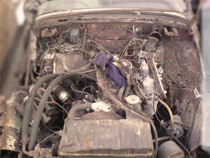Iron Oxide Poisoning, Tin Worm or the Dreaded Rot, no matter what name you give it rust will always be rust. Preventing rust should be an obsession for the classic car enthusiast. Even the smallest area of rust can not only ruin the appearance of an otherwise perfect car, it can also quickly spread! Prevention is better than cure when it comes to rust, as once its there it can be very difficult to get rid of completely.

Although there are many rust converters and rust neutralizers available, there effectiveness depends on having access to the entire area of rust, this is difficult if your classic is starting to rust in a hard to get at place, and with some classics this is pretty much everywhere.
Rust prevention is the best approach, the only problem is you need to start with a rust free (or at the very least almost rust free!) car.
If you a restoring a car, rust prevention should always be on your mind, a good coat of paint (such as hammerite) in those normally inaccessible areas will provide extra protection against future rusting. Whilst correctly sealing the seams of welds will help prevent rust at the edges of your new metal. When painting your restoration project use a good zinc primer to coat any bare metal prior to any other paint layers. This encapsulates the new metal in a rust proof 'jacket' and will keep your classic alive and well for many years to come.
Products
There are many products on the market for both rust prevention and for rust conversion/neutralization. Lets start with the neutralizers. Lets face it, most of us have some rust on our classics some where, and if you think you don't, your just not looking in the right places.
Neutralizers and converters
These products are designed to treat rust. These work by converting the top surface of the rust into a protective layer of 'organic' iron compound. This layer will prevent oxygen and water from reacting with the metal underneath. The problem with this is that it encapsulates the rust between this layer and the 'healthy' metal underneath, if the rusty area was not completely dry on application the existing rust will spread from underneath the neutralizer. Also it is often difficult to successfully treat the entire surface of the rust, as it is easy to miss pits and other awkward surface features commonly found on rusted metal. Missing just the smallest area when treating rust with one of these products renders the whole operation pointless.
Prevention
Prevention is better than cure. Fortunately for us classic enthusiasts there are a multitude of products that can offer preventative protection against rust. Protection comes in many forms, from oils and waxes, fluids and coatings the range is vast and the choice of product is a personal one. I personally favor Dinitrol products and have found them to be very effective and easy to use while still remaining affordable. (Message for Dinitrol - I'll say more nice things if you give me money... Message for other rust prevention companies - I am open to bribery)
Here is a brief run down of the main areas that require attention.
Remember to keep checking for the first signs of rust, its easier to treat if caught early.